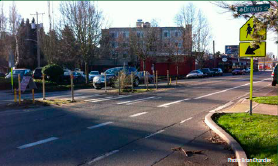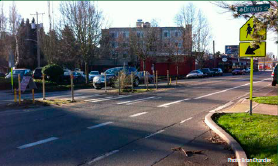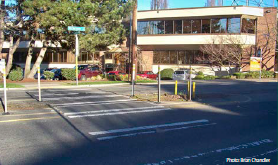SAFETY IMPROVED & EXTREME SPEEDING VIRTUALLY ELIMINATED
| Objective | Features | Results |
|---|---|---|
|
|
|


In August 2010, the Seattle Department of Transportation (SDOT) completed a Road Diet on Nickerson Street from 13th Avenue West to Florentia Street. The goal of this project was to improve pedestrian safety by reducing exposure to multiple lanes of traffic and increase driver compliance with the speed limit. Prior to the reconfiguration, there were two travel lanes in each direction. The street was restriped to one lane in each direction with a center two-way left-turn lane and bicycle lanes.
Carrying approximately 18,500 vehicles per day, Nickerson Street is in the Queen Anne neighborhood of Seattle. The corridor land use is mixed, including service-oriented businesses, restaurants, multi-unit residences, and the Seattle Pacific University campus.
 |
 |
| To improve pedestrian safety, the Road Diet project incorporated crosswalks with curb bulb-outs and pedestrian refuge islands. | |
BACKGROUND
Top end speeders have been reduced by more than 90%
Prior to the Road Diet, SDOT was removing mid-block crosswalks on the city's 4-lane roads due to safety considerations. This decision was not popular with the community, and as a way of addressing the concerns, SDOT implemented the Nickerson Street Road Diet, which included the reintroduction of marked crosswalks and addition of curb bulb-outs and refuge islands. This configuration provides an opportunity for increased safety since pedestrians do not have to cross all lanes of traffic at once.
By decreasing the travel lanes to only one in each direction, SDOT also hoped to lower the speeds along Nickerson Street. In 2007, the agency completed a speed study and found that 90 percent of drivers were exceeding the 30 mph speed limit.
RESULTS
One year after the conversion, SDOT completed a before-and-after study on the Nickerson Street Road Diet. The outcome was what SDOT had hoped for – a safer road. Speeding along Nickerson Street decreased dramatically, and collisions were reduced. The results also showed that the Road Diet accomplished this without significant diversion of traffic to parallel routes. Nickerson Street only experienced a 1 percent decrease in traffic volumes between 2009 and 2011.
| Before | After | Change | |
|---|---|---|---|
| Westbound | 17% | 1.4% | -92% |
| Eastbound | 38% | 1.5% | -96% |
| 5-Year Average | One Year Post Project | Change |
|---|---|---|
| 33.6 | 26 | -23% |
Source: City of Seattle Department of Transportation, "Nickerson Street Rechannelization Before and After Report," 2012.
